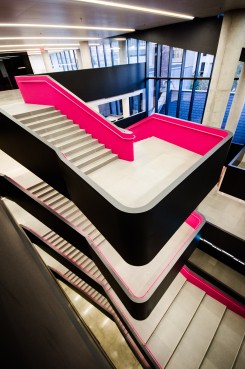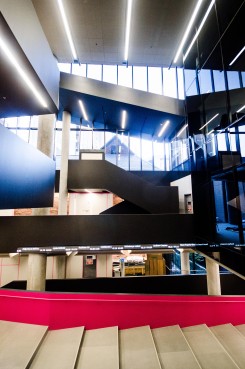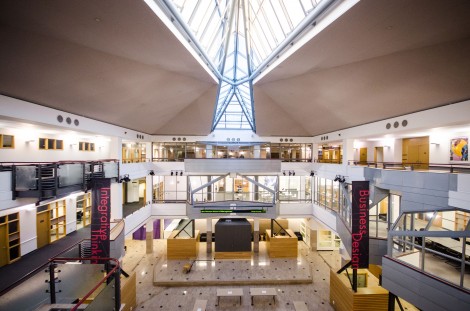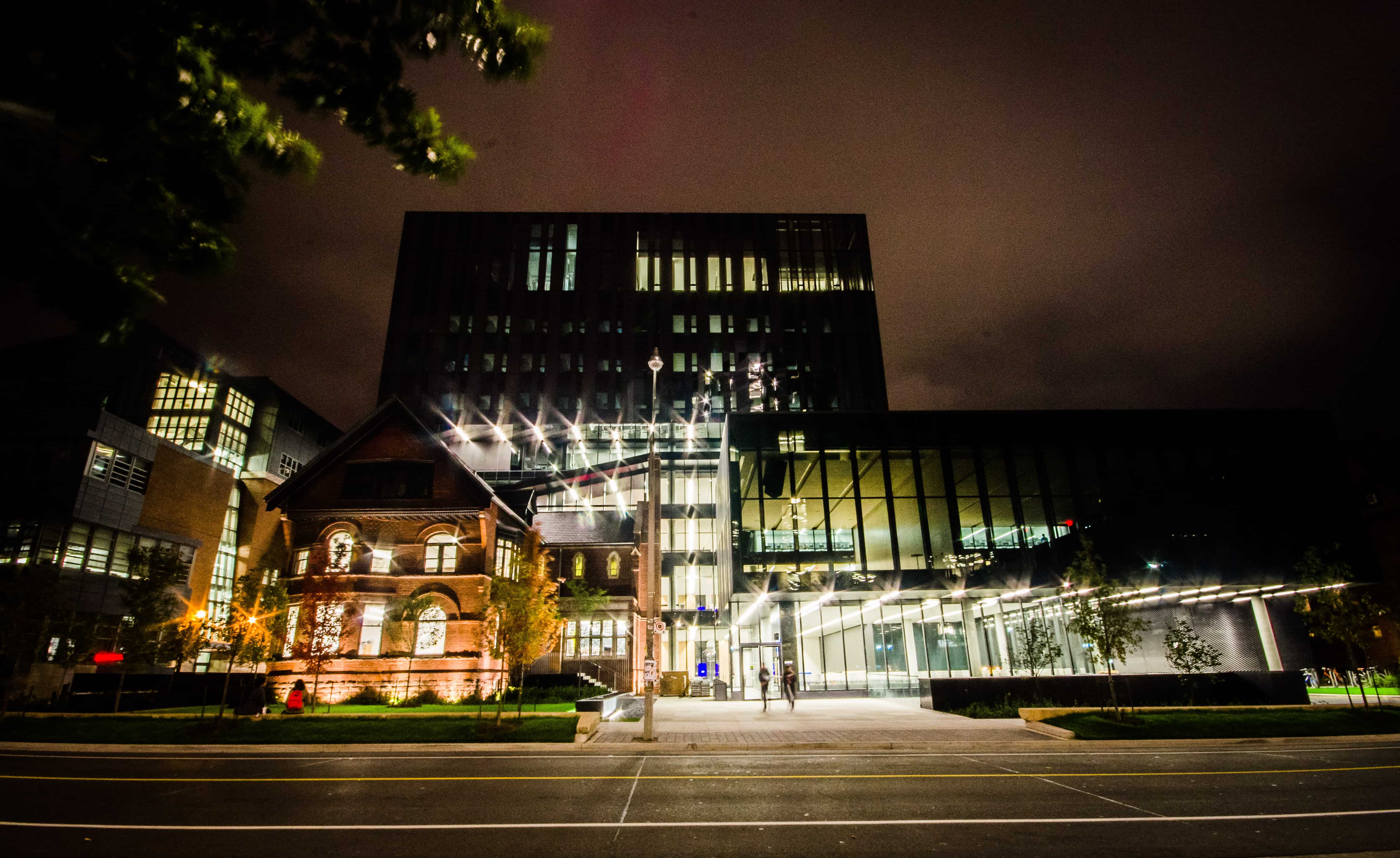Roger Martin believes in teaching students to think critically. “I’m worried [about] what’s happening in business education generally: that they’re leaning all sorts of apps, all sorts of models and apps, but the foundational thing that they need to understand is how to think in a broad, holistic way about how the world works.”
Martin has implemented a very different model for business education in his 14 years as dean of the Rotman School of Management. The dual concepts of “integrative” and “design” thinking, buzzwords for a curriculum focused more on creative solutions than rote answers, have been lauded and emulated by industry leaders and institutions far beyond the school’s St. George enclave.
 The school’s philosophy goes beyond teaching students how to manage assets and read stock charts. “From [the design] world, it’s that ‘create stuff that doesn’t exist’ piece of the puzzle, and from liberal arts it is ‘teach people this fundamental, foundational skill level,’” Martin says. “And my reason for that, what motivated me, is that I worry that business education had — writ large — become too much at the applications level.”
The school’s philosophy goes beyond teaching students how to manage assets and read stock charts. “From [the design] world, it’s that ‘create stuff that doesn’t exist’ piece of the puzzle, and from liberal arts it is ‘teach people this fundamental, foundational skill level,’” Martin says. “And my reason for that, what motivated me, is that I worry that business education had — writ large — become too much at the applications level.”
That philosophy, or at least the results it seems to produce, has led to a very competitive global standing: Rotman ranked forty-fourth in the Financial Times 2012 Global MBA Rankings, outperforming other prominent Canadian management institutions including York University’s Schulich School of Business (59) and Western University’s Richard Ivey School of Business (68).
In his understated office in Rotman’s old North Wing, I suggest to Martin that a lot of Canadians don’t seem to realize how Rotman stacks up against its domestic competitors. He disagrees. “If you just look at the statistics of who applies to us, if they get accepted at us, Ivey and Schulich, what you describe does not play out,” he explains. “Not that we’re arrogant about it; we have to do everything right, and do admissions terrifically and make sure that we’re taking care of the students.
“But I do not go to sleep any night worrying about there being some schism between the rankings and how we’re perceived by students. We’re doing just fine on that front.”
The Financial Research and Trading Lab nestled on an upper floor of the North Wing is one of the tools Rotman students use to stay competitive in an increasingly difficult job market. “We see it a lot like a flight simulator,” Marco Salerno, the manager of the lab, tells me. “Students have to practice before going into the industry — it’s like a pilot has to practice on a flight simulator.
Varsity Vignettes: A Walk Through Rotman from The Varsity on Vimeo.
“It’s basically the same in the lab — we show them risk management strategies, different aspects of the market, and then they can go into [the work world] and apply what they’ve learned.”
The lab itself is a disarmingly plain room — dimly lit, with rows of computers stretching from end to end. It’s only when you look up to the ever-changing symbols and numbers of the two LED stock tickers in either corner that you realize this isn’t just a computer room.
“We have two boards, and they show you real-time indexes,” Salerno explains. “We have the Nikkei, the Japanese index, the S&P500, NASDAQ — so the main ones. And on the other board we have commodities and foreign exchange rates.”
Other universities have similar facilities, but Rotman’s lab has a few tricks of its own. “We’ve developed RIT [Rotman Interactive Trader], which is a market simulation software,” says Salerno. “It allows professors to simulate the market and show students different aspects [of the market].”
 Financial software development is one way the lab gets its funding. “We started up initially with one of the Ontario Research and Development Challenge Funds, but now it’s primarily part of our school budgets,” explains professor Tom McCurdy, the lab’s founding academic director. “We have some revenue-generating activities and products that help fund it for the data services and the classes that we provide for students.”
Financial software development is one way the lab gets its funding. “We started up initially with one of the Ontario Research and Development Challenge Funds, but now it’s primarily part of our school budgets,” explains professor Tom McCurdy, the lab’s founding academic director. “We have some revenue-generating activities and products that help fund it for the data services and the classes that we provide for students.”
I consider asking if I can play with some of the software, hoping to discover some hidden talent for playing the stock market that might supplement the journalist’s salary I’m destined to make. But I look over to the weird and wonderful combinations of letters and prices on the ticker boards that mean nothing to my untrained eyes, and I quickly reconsider.
In what seems like a metaphor for the huge role that technology and to-the-second data play in financial trading, the lab will soon be expanding into space created by the shifting of the school’s library to the new South Wing. “We’re going to be constructing a new lab which will open next fall, and that’ll start construction in the spring,” McCurdy says.
But there will be a slight change in the lab’s identity: thanks to a $1.75 million donation, the new facility will be named after the BMO Financial Group.
Money from corporations and corporate donors has always played a significant role at Rotman, with the school’s name the most obvious example. Although the University of Toronto offered courses in management from as early as 1902 and the Faculty of Management has existed since 1971, it wasn’t until natural resource and financial magnate Joseph L. Rotman’s $15 million donation in 1997 that the modern School of Management was born.
Rotman’s contribution was very controversial at the time. In a January 1997 cover story, The Varsity detailed the terms of the donor agreement, which included several clauses that opponents claim severely limited the university and faculty of management’s academic freedom.
The agreement required that that “U of T [rank] the faculty of management as one of its ‘highest priorities’ for the allocation of university funding, ensuring to its ‘best efforts’ that business education receives continuing focus.” Rotman’s foundation also had the right to receive yearly reports from the faculty detailing its progress and adherence to a “vision” document constructed at the time of the agreement.
Philosophy professor-emeritus Bill Graham was president of the University of Toronto Faculty Association at the time, and one of the agreement’s most vocal opponents. “There was a document called “the ‘vision,’ and it talked about non-qualified support for and commitment to the values and principles underlying the ‘vision’ by the members of the faculty of management, as well as the central administration. And such language we felt blatantly violated the university’s policy commitment to academic freedom.”
In response to the outcry from faculty and some students, the agreement underwent substantial revisions. But some controversial provisions remained, including one that allowed the foundation to bring in an outside expert from the Association of American Universities to recommend policy changes if it was felt that the school of management was failing to live up to the criteria set out in the agreement.

“What we were concerned with of course was despite the fact that it had gone through all the university committees — three academic committees — the items about academic freedom were never brought up in those committees,” says Graham. “And we were quite horrified.”
The donation was to be paid out over 14 years, ending in December 2011. That time span coincides almost exactly with Martin’s term as dean, and he tells me that the provisions that caused so much controversy in 1997 were never exercised. “It didn’t feel like a sword hanging over my head,” he says. “So much so that I’ve actually never read the entire agreement. I probably should have, but in fourteen years Joe Rotman has done nothing but be unbelievably supportive.”
Martin believes that Rotman was only trying to look out for the faculty’s best interests. “All he wanted was the business school to aspire to high levels. That’s it. And there were things, some of which I’m aware of — as I say, I never read the thing cover to cover — but there were some things in the agreement that they could insist on but that were only about quality standards.
“So things like, he wanted to make sure that the searches for the Rotman chairs were international searches.”
Martin acknowledges that academic freedom is a serious concern, but he doesn’t believe that Rotman’s approach impinged on that. “I don’t dispute the notion that we should be careful… But as I say, it is a fact that not once in 14 years has any such thing even been hinted at, mentioned, anything.”
Graham emphasizes that academic freedom and high standards are not incompatible. “Of course we wanted to see the school of management succeed, but not at the expense of academic values,” he says. “We’re happy that the school has done well, but we certainly need also to have full protection for academic freedom and the freedom of appointment.”
Rotman’s donations — he made a second, $18 million contribution in 2007 — are of course not the school’s only source of income. And Martin emphasizes that while donors play an important role, it’s a relatively small one. “What’s great about the donations is that they add to your capacity to do things, but there’s this huge base load of expenditures that have to be made.”
Running the School of Management is a very expensive undertaking. Rotman’s academic expenditures for 2011, according to figures published by U of T, were in the order of $71 million — almost as much as those of the whole of the U of T’s Scarborough campus. Part of those costs are the high salaries paid to faculty; six of the top 10 salaries paid to University of Toronto employees for 2012 went to Rotman professors and administrators, according to the Ontario Ministry of Finance Public Sector Salary Disclosure (more commonly known as the “sunshine list”).
Martin believes you get what you pay for. “It’s extremely expensive to have a good business school. So the salaries are higher; in order to get world-class faculty you have to pay those salaries. Student services are greater.
“The nature of competition in the business school space means you have to spend every cent you can get.
And Rotman does spend a lot on its students — $71 million for approximately 1,500 students, compared to about $7 million for some 400 students at the Faculty of Architecture, another faculty primarily focused on graduate studies.
But Rotman students’ tuition fees, some twenty-six to forty-eight thousand dollars per year depending on length of degree and immigration status, reflect this. “It’s a lot of money at Rotman, almost $85,000 for the program,” says Rudi Morvan, a part-time MBA student who moved from France but counts as a domestic student because he has permanent residency. “So you basically cannot fail, because you cannot after the three-year program … be in the same position as you were before the program, making the same amount of money.
The payoff, though, can be substantial. The Financial Times figures show that Rotman graduates see an average salary increase of just over 100 per cent after finishing their degrees. The average salary for a Rotman MBA graduate three years after finishing the program is some $96,000, and 85 per cent of the most recent graduating class had jobs within three months.
Morvan finds those figures are very encouraging. “Those statistics, for me, it was a really important factor. [It was] the thing that I compared with all the other schools, basically the — let’s call it the ‘return’ that you can get out of your MBA. Because I view it as an investment, an investment in yourself.”
And Rotman’s figures are even more impressive given the state of the job market today, according to Morvan. “An MBA is always good in all types of economic scenarios — downturn or growth — it’s always good to have, I believe, an MBA.”
There’s value to an MBA beyond the financial, of course. “It was a way to be the same as everybody else — having graduated from a university in Canada, instead of having graduated from a university in France only,” says Morvan, explaining that the program has prepared him for work in Canada. “So there was a mingle factor for me.”
Many of his fellow students seem to agree. Forty-eight per cent of the incoming full-time MBA class of 2014 are international students. That’s a change from when Martin arrived in 1998. “Was it purposeful? Yes. When I got here we had a class of about 130 students per class and there were about 10 international students. Now its 300 and there are a close to 150 international students. And that’s a completely different experience.”
Students clearly believe a Rotman MBA will help their careers — the school’s recently-achieved doubling of its capacity suggests there is no shortage of prospective applicants. But does Rotman have a wider purpose beyond training the next generation of Canada’s entrepreneurs and industrialists? And how does it work with the rest of the university?
Sure, U of T students now have a sparkly new building to enjoy. And the flood of press releases that clutter The Varsity’s inboxes suggest that Rotman professors’ research interests stretch far beyond money-making (“Joint study by Rotman School researcher shows signature placement curbs cheating”; “Blood drives do better with incentives, says University of Toronto study”). But Martin suggests that one of the school’s biggest contributions is to the greater economic health of the area.
“I think the Rotman school is doing the province of Ontario, the GTA, a huge service because what happens is we track in about 50 per cent international students and a large slug of them stay.
“And so we’ve just imported fantastic human capital from around the world to stay in Toronto.”


